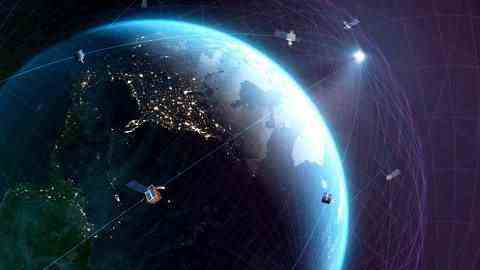It “rains” satellites. Of 49 Starlink satellites launched by SpaceX on February 3, 40 have crashed again. More will probably follow. Why is that?
Download Audio (2.4MB | MP3)
Establishing Internet connections with the help of huge satellite networks in space – that is the goal of several companies. The best known is probably SpaceX, which started launching rocket after rocket into space in 2019, ultimately stationing up to 42,000 satellites there. Regions of the world that are poorly supplied by cable should be able to get fast broadband internet in this way.
Every few weeks, a SpaceX rocket launches up to 60 Starlink satellites into space in one fell swoop. 2,000 are already there, but SpaceX was unlucky with the latest batch of satellites launched on February 3: Why are the Starlinks falling out of the sky in rows instead of swinging into orbit?
On February 3, 2022, the SpaceX company launched another group of its Starlink satellites into space. A majority of the satellites with this charge have now crashed.
imago images
imago images/UPI Photo
Solar storm knocked satellites out of orbit
Space travel in low earth orbit has a powerful and unpredictable adversary that peaks every 11 years on average: the sun. It was a solar storm that caused 40 of the 49 launched satellites of the Starlink network to burn up again in the earth’s atmosphere just a few hours after launch. Not good news for Elon Musk and his company Space X, which is just building this network.

There are always violent eruptions on the sun, which throw large showers of particles together with magnetic fields into space. You can also hit the earth.
imago images
imago/PantherMedia/Sanda Stanca
Remnants of the earth’s atmosphere at an altitude of 200 kilometers
But it was foreseeable that something like this could happen. After the start, the Starlinks initially move in a rather low orbit at a little more than 200 kilometers altitude. At this altitude, remnants of the earth’s atmosphere are still present. Everything that flies there rubs against these remains of the atmosphere and therefore slows down over time and sinks.
Sun’s eruption sends magnetic field bubble
Of course, SpaceX also knows this and therefore normally brings its satellites to higher altitudes quickly after the separation from the rocket. But this time the sun was a little faster. An eruption at the sun’s surface sent a magnetic field bubble along with masses of particles toward Earth. This solar storm hit the Earth’s atmosphere, heating it up and causing the Earth’s atmosphere to expand into space even further than usual.

Northern lights are caused by electrically charged particles. Solar winds plunge from space into the uppermost atmosphere of the earth at very high speeds.
imago images
imago images/imagebroker
Starlink satellites burned up in Earth’s atmosphere
For the Starlinks, the universe must have suddenly felt very tough as more and more gas atoms penetrated from the deeper earth’s atmosphere to an altitude of 200 kilometers. Satellite operators are familiar with this phenomenon and in such cases quickly raise the orbits again by firing engines to compensate for the friction losses. But the Starlink satellites couldn’t do it anymore, crashed and burned up in the earth’s atmosphere.
Friction effect important for disposal of defective satellites
Despite this incident, SpaceX will not increase the altitude at which the Starlink satellites will be launched. You actually want to use the friction effect for waste disposal. Because it can happen that among the assembled satellites of the Starlink network there are also non-functional ones. They should then, with full intention, quickly dive back into the earth’s atmosphere and burn up there.
The satellites will only be placed in higher and final orbits after the first functional tests have been passed. Space X will have to brace for more storm events in space – solar activity fluctuates in an 11-year cycle and the sun’s most active phase in the new cycle is yet to begin.

It cannot be ruled out that more Starlink satellites will fall from the sky in the coming years.
imago images
imago images/Science Photo Library

